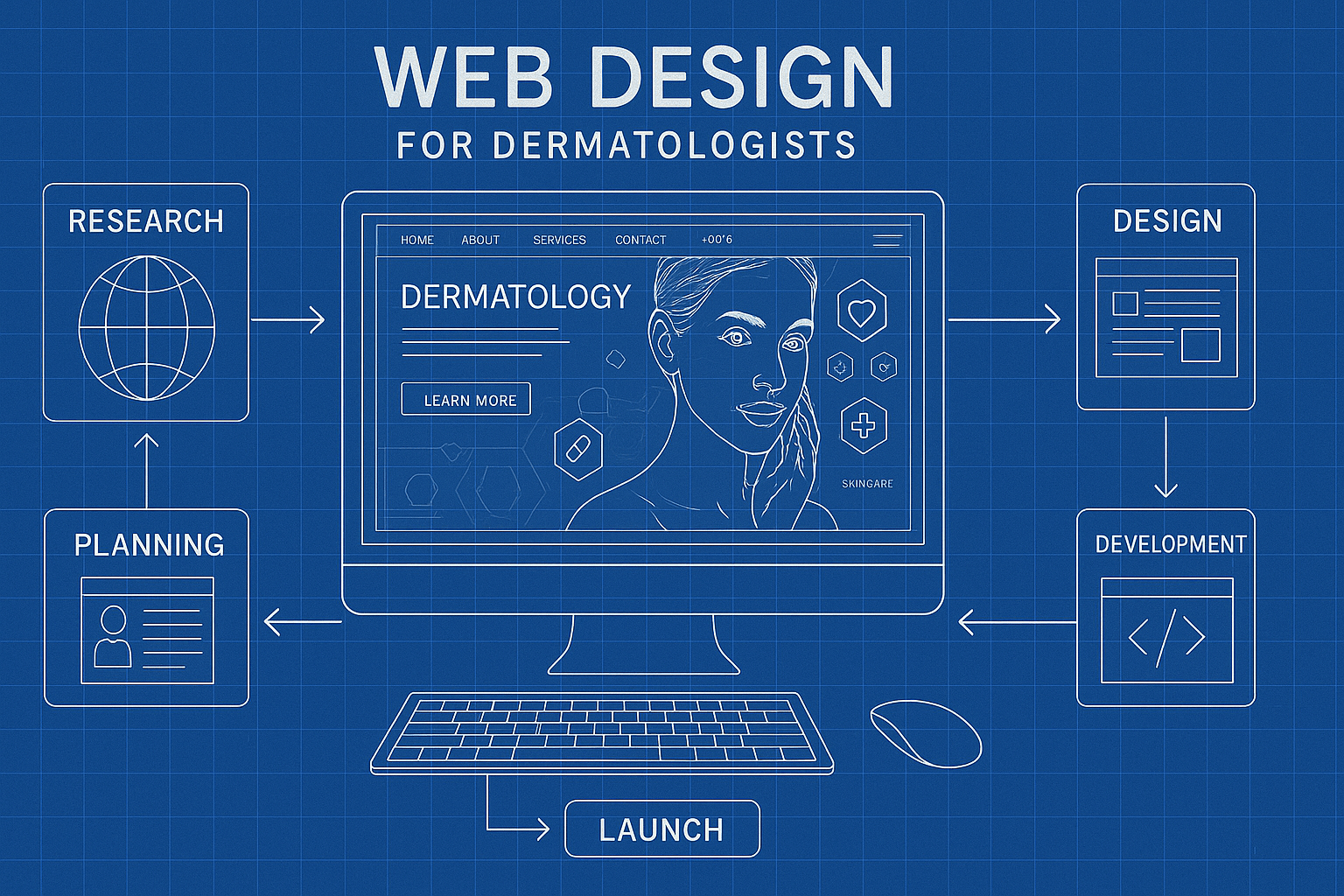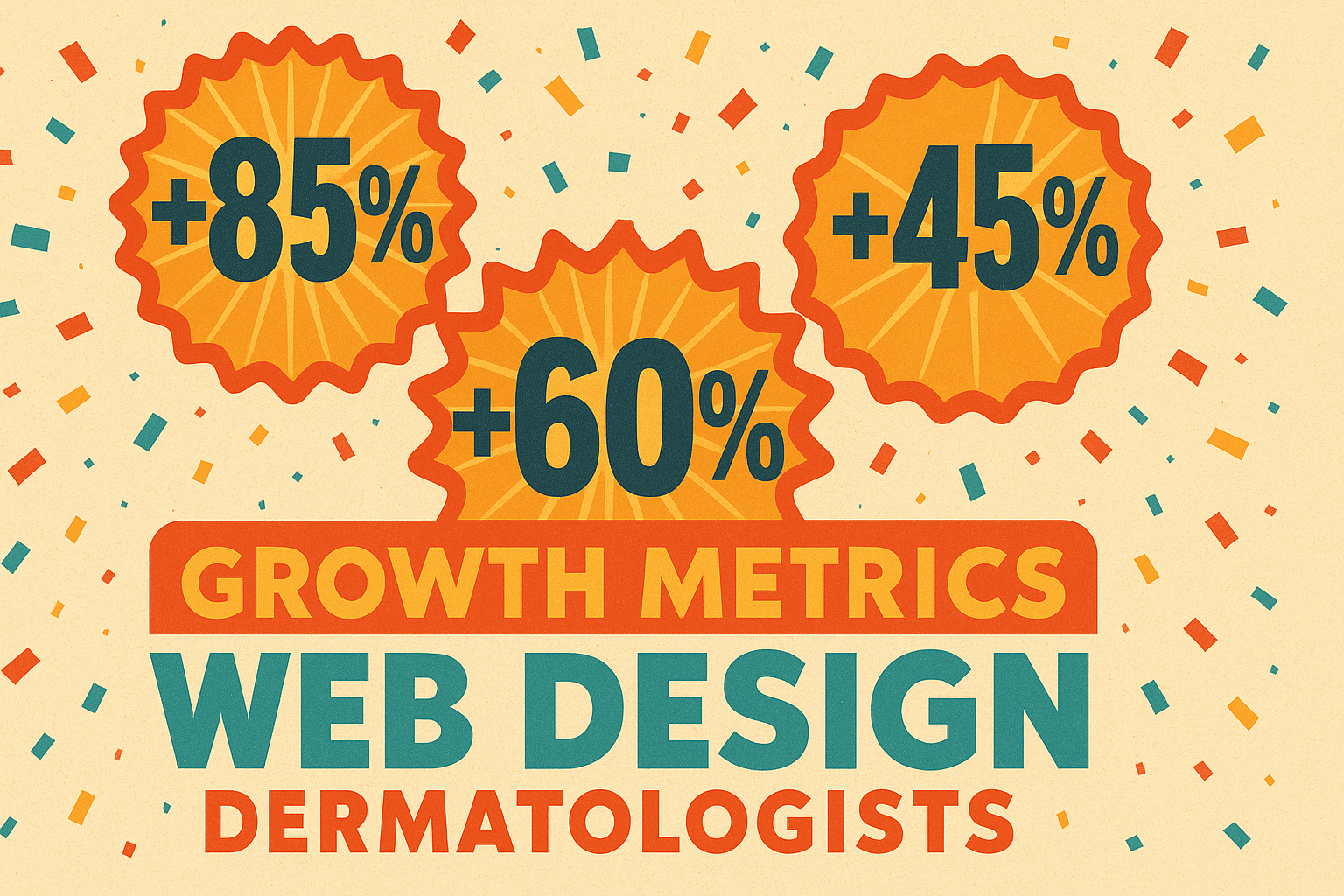Web Design for Dermatologists: Templates, Examples, KPIs
by Design Delulu Editorial · October 2, 2025

Your website is the first consultation most patients will ever have with your dermatology practice. In an industry where trust, credibility, and visual presentation are paramount, your digital presence must reflect the same level of professionalism and care you provide in the treatment room. A strategically designed website doesn't just showcase your services—it actively converts visitors into booked appointments, educates patients about treatment options, and positions your practice as the go-to authority in your market.
For dermatologists, effective web design means balancing clinical credibility with approachability, presenting complex medical information in digestible formats, and creating seamless patient journeys from symptom research to appointment booking. Whether you're launching a new practice, rebranding an established one, or simply need to compete more effectively in local search, the right web design strategy drives measurable results: more qualified leads, higher conversion rates, and a stronger return on every marketing dollar you invest.

Why Web Design Matters for Dermatology Practices
Dermatology is a uniquely visual medical specialty, and your website must reflect that reality. Patients searching for acne treatment, cosmetic procedures, skin cancer screenings, or chronic condition management are making critical decisions based on what they see online. A poorly designed website signals outdated practices, lack of attention to detail, and missed opportunities to educate and convert high-intent visitors.
Modern dermatology patients expect more than a digital brochure. They want before-and-after galleries that demonstrate your expertise, clear explanations of treatment protocols, transparent pricing information, online booking systems, and mobile-optimized experiences that work flawlessly across all devices. When your website delivers on these expectations, you reduce friction in the patient acquisition process, increase appointment bookings, and build lasting trust with your community.
Beyond aesthetics, strategic web design directly impacts your practice's visibility in search engines. Google rewards fast-loading, mobile-friendly, accessible websites with higher rankings—which means more organic traffic from patients actively searching for dermatological services in your area. When combined with proper schema markup, local SEO optimization, and conversion-focused page structures, your website becomes your most valuable marketing asset, working around the clock to attract and convert new patients.
Key Benefits of Professional Web Design for Dermatologists
- Mobile-First Responsive Design: Over 60% of healthcare searches happen on mobile devices. Your website must deliver flawless experiences across smartphones, tablets, and desktops, with touch-optimized navigation, readable typography, and fast-loading images that don't sacrifice quality.
- Conversion-Optimized Patient Journeys: Strategic placement of appointment booking CTAs, clear service explanations, trust signals like credentials and certifications, and streamlined contact forms that reduce abandonment and maximize consultation requests.
- Performance and Core Web Vitals Excellence: Fast page load times, optimized images, efficient code, and superior user experience metrics that satisfy both Google's ranking algorithms and impatient visitors who expect instant access to information.
- HIPAA-Compliant Contact Forms and Booking Systems: Secure patient communication channels that protect sensitive health information while making it effortless for patients to schedule appointments, request consultations, or ask preliminary questions.
- Accessibility-First Component Design: WCAG-compliant patterns ensuring your website is usable by patients with disabilities, including proper heading structures, alt text for images, keyboard navigation, and sufficient color contrast ratios.
- Content Management System Integration: Easy-to-update CMS platforms that allow your team to publish blog posts, update service descriptions, add new team members, and manage content without requiring developer assistance for every change.
- Scalable Design System Architecture: Reusable components, consistent visual language, and modular page templates that allow your website to grow with your practice—adding new locations, services, or specialties without rebuilding from scratch.
- Local SEO Foundation: Properly structured NAP (Name, Address, Phone) information, location pages for multi-site practices, embedded Google Maps, and schema markup that helps search engines understand and rank your practice for local searches.
How Our Web Design Process Works for Dermatology Practices
- Discovery and Strategic Alignment: We begin by understanding your practice's unique positioning, competitive landscape, patient demographics, and business objectives. This phase includes stakeholder interviews, competitor analysis, current website audits, and defining clear success metrics tied to revenue goals—whether that's increasing consultation bookings, promoting specific high-value procedures, or expanding into new treatment areas.
- Information Architecture and Content Strategy: We map your services to patient search intent, creating logical site structures that match how patients actually think about dermatological problems. This includes developing service taxonomies (medical vs. cosmetic), treatment category pages, condition-specific landing pages, and content hierarchies that guide visitors from awareness to decision with minimal friction.
- Wireframing and User Experience Design: Before touching visual design, we create detailed wireframes that establish page layouts, content prioritization, conversion flows, and interaction patterns. This ensures we're solving the right problems before investing in pixel-perfect designs—focusing on functionality, user needs, and business objectives first.
- Visual Design and Brand Expression: With strategy and structure validated, we develop high-fidelity designs that reflect your brand personality while meeting patient expectations for medical professionalism. This includes custom photography art direction, color palette development, typography systems, iconography, and UI component design that balances clinical credibility with warmth and approachability.
- Development and CMS Implementation: We build your website using modern development practices: clean semantic HTML, performance-optimized CSS, progressive JavaScript enhancement, and enterprise-grade CMS platforms like WordPress, Webflow, or custom solutions. All development follows accessibility standards, includes comprehensive browser testing, and implements analytics tracking from day one.
- Quality Assurance and Pre-Launch Testing: Rigorous testing across devices, browsers, and screen sizes ensures flawless functionality. We verify form submissions, test booking integrations, validate load times, check accessibility compliance, review SEO implementations, and confirm analytics tracking before launch.
- Launch, Training, and Knowledge Transfer: We handle all technical aspects of deployment, including DNS configuration, SSL certificate setup, 301 redirects from old pages, and search engine indexing. Your team receives comprehensive CMS training, content guidelines, and ongoing support documentation to maintain and grow your website confidently.
- Post-Launch Optimization and Iteration: Launch is just the beginning. We monitor performance metrics, analyze user behavior, conduct A/B tests on conversion elements, and continuously refine your website based on real patient data. Monthly reporting keeps you informed on key metrics, while quarterly strategy sessions ensure your website evolves with your practice goals and market conditions.

Comprehensive Deliverables for Your Dermatology Practice
- Strategic Sitemap and Information Architecture: Complete documentation of your website structure, including page hierarchy, navigation systems, internal linking strategy, and content organization that supports both user experience and SEO performance.
- Detailed Wireframes and User Flow Diagrams: Low-fidelity blueprints showing exact layout, content placement, and interaction patterns for every template type—from homepage to service pages to blog posts—ensuring alignment before visual design begins.
- Comprehensive Design System and UI Kit: Complete visual language documentation including color palettes, typography scales, spacing systems, button styles, form elements, iconography, photography guidelines, and reusable component libraries that maintain consistency as your site grows.
- Fully Responsive Website Templates: Production-ready designs optimized for mobile, tablet, and desktop viewports, including homepage, service pages, about pages, provider profiles, blog templates, contact pages, and any custom page types specific to your practice needs.
- Custom Before/After Gallery Systems: Purpose-built components for showcasing treatment results with proper image optimization, filtering capabilities, privacy considerations, and engaging presentation that demonstrates your clinical expertise.
- CMS Setup, Configuration, and Training: Fully configured content management system with custom post types, taxonomies, user roles, and publishing workflows—plus comprehensive video training and documentation so your team can confidently manage content updates.
- Analytics Implementation and Dashboard Setup: Google Analytics 4 configuration, conversion tracking, goal setup, custom reports, and integrated dashboard showing key metrics like appointment requests, phone calls, form submissions, and traffic sources—all connected to your business objectives.
- SEO Foundation and Technical Optimization: Complete on-page SEO including optimized title tags, meta descriptions, header hierarchies, schema markup, XML sitemaps, robots.txt configuration, and technical SEO best practices that give your website a strong search engine foundation.
- Performance Optimization and Core Web Vitals: Image compression and lazy loading, CSS and JavaScript optimization, caching strategies, CDN configuration, and all technical optimizations necessary to achieve excellent Core Web Vitals scores and fast page load times.
- Accessibility Compliance Documentation: WCAG 2.1 AA compliance audit report, remediation documentation, and accessibility testing results ensuring your website is usable by all patients regardless of ability.
Best Practices for Dermatology Website Design
- Prioritize High-Intent Pages First: Focus initial efforts on pages that drive appointments—service pages for high-value treatments, location pages with booking CTAs, and homepage hero sections that immediately communicate your value proposition. Perfect these conversion-critical pages before expanding to nice-to-have content.
- Use Real Patient Photography Whenever Possible: Stock photos of generic doctors and patients damage credibility. Invest in professional photography showing your actual practice, real team members, authentic treatment rooms, and genuine before/after results (with proper consent). Authenticity builds trust faster than polished stock imagery.
- Make Appointment Booking Effortless: Reduce friction in your conversion funnel by offering multiple booking options—online scheduling integrated with your practice management system, click-to-call phone links, contact forms, and even SMS options. Place CTAs prominently on every page, above the fold, and test different messaging to optimize conversion rates.
- Structure Services Around Patient Problems, Not Medical Terms: Patients search for "acne treatment" not "comedone extraction," "wrinkle removal" not "botulinum toxin therapy." Organize your service pages around the problems patients are trying to solve, then educate them on your solutions using clear, jargon-free language while maintaining medical accuracy.
- Implement Comprehensive Schema Markup: Use structured data to help search engines understand your practice—LocalBusiness schema with detailed NAP information, MedicalOrganization schema, MedicalProcedure schema for services, Physician schema for provider profiles, and FAQPage schema to appear in rich results.
- Optimize for Local Search Dominance: Create dedicated location pages for each office, optimize for "dermatologist near me" queries, maintain consistent citations across directories, encourage and showcase patient reviews, and build location-specific content that demonstrates community involvement and local expertise.
- Build Trust with Social Proof Throughout: Strategically place trust signals—board certifications, professional memberships, years of experience, patient testimonials, before/after galleries, awards, media mentions, and patient review scores—especially on high-intent pages where visitors are evaluating whether to book consultations.
- Create Content That Matches Search Intent: Develop blog posts, condition guides, and FAQ pages that answer the exact questions your ideal patients are asking Google. Target long-tail keywords with helpful, comprehensive content that establishes your expertise and captures organic traffic from patients early in their research process.
- Test Ruthlessly and Iterate Based on Data: Launch with measurement in place, then continuously test variations of headlines, CTA placements, form fields, button colors, page layouts, and content approaches. Use heatmaps to understand user behavior, A/B testing to validate improvements, and analytics to identify bottlenecks in your conversion funnel.
- Plan for Content Velocity from Day One: Design your website with content marketing in mind—easy-to-use blog systems, shareable infographics, downloadable patient resources, video hosting capabilities, and social media integration. Your website should make it simple to publish fresh, valuable content that attracts organic traffic and demonstrates ongoing expertise.
Industry-Specific Web Design Strategies for Dermatologists
- Map Content to Patient Journey Stages: Awareness stage content addresses general skin concerns and symptoms. Consideration stage content compares treatment options and explains procedures. Decision stage content focuses on your unique qualifications, results, pricing transparency, and booking. Structure your website to serve patients at every stage with appropriate content and CTAs.
- Separate Medical and Cosmetic Service Architectures: Patients seeking medical dermatology (skin cancer treatment, psoriasis management, eczema care) have different mindsets and urgency levels than those exploring cosmetic procedures (Botox, laser treatments, chemical peels). Create distinct user pathways with appropriate tone, imagery, and conversion strategies for each.
- Leverage Video to Demystify Procedures: Patients feel anxious about dermatological procedures. Short educational videos showing what to expect during consultations, treatment walkthroughs, recovery timelines, and result expectations dramatically reduce anxiety and increase conversion rates. Video also improves SEO performance and time-on-site metrics.
- Implement Condition-Specific Landing Pages: Create dedicated pages for each condition you treat—acne, rosacea, psoriasis, eczema, skin cancer, melasma, etc. Optimize these pages for condition-specific search terms, provide comprehensive information, and include clear pathways to relevant treatment pages and booking CTAs.
- Showcase Clinical Expertise Through Content Marketing: Publish authoritative content about dermatological topics, new treatment developments, skincare science, and preventive care advice. This positions you as a thought leader, captures organic search traffic, and gives patients reasons to return to your website beyond booking appointments.
- Build Transparent Pricing Pages When Possible: While insurance complications make medical dermatology pricing complex, cosmetic procedures offer opportunities for price transparency. Providing clear pricing ranges or starting-from prices reduces patient anxiety, qualifies leads, and can differentiate your practice from competitors who hide pricing.
- Create Robust Provider Profile Pages: Patients want to know who will be treating them. Develop detailed provider bios including education, board certifications, specializations, years of experience, research publications, professional photos, and even personal touches like hobbies or community involvement that build human connections.
- Optimize for Voice Search and Featured Snippets: Structure FAQ pages and condition pages to answer common voice search queries like "What causes acne?" or "How much does Botox cost?" Use question-based headings, concise answers in 40-60 words, and proper schema markup to capture featured snippet positions and voice search traffic.
- Implement Telemedicine Capabilities When Appropriate: Many dermatological conditions can be initially evaluated remotely. If you offer teledermatology services, make this prominent on your website with clear explanations of which conditions are appropriate for virtual visits, how the process works, and easy scheduling.
- Integrate Patient Portal Access Prominently: If you use patient portals for appointment management, test results, prescription refills, or billing, make portal access easy to find on your website. Convenient digital services improve patient satisfaction and reduce administrative burden on your staff.
Measuring Success: Key KPIs for Dermatology Website Performance
Effective web design is measurable. Track these metrics to understand ROI and identify optimization opportunities:
- Primary Conversion Metrics: Appointment booking form submissions, phone call clicks, online scheduler completions, consultation request forms, and contact page submissions—these directly indicate patient acquisition success.
- Conversion Rate by Traffic Source: Compare conversion rates from organic search, paid ads, social media, and direct traffic to understand which channels deliver highest-quality visitors and where to focus marketing investment.
- Service Page Performance: Track which treatment pages generate the most conversions, time-on-page metrics, scroll depth, and exit rates to identify top-performing content and pages needing improvement.
- Local Search Visibility: Monitor Google Business Profile impressions, clicks, and ranking positions for key local search terms like "dermatologist in [city]" and condition-specific local queries.
- Organic Search Traffic Growth: Track month-over-month and year-over-year organic traffic increases, new keyword rankings, featured snippet captures, and search impression growth as indicators of SEO effectiveness.
- User Experience Metrics: Monitor Core Web Vitals (LCP, FID, CLS), page load times, bounce rates, pages per session, and average session duration to ensure technical performance and engagement remain strong.
- Mobile vs Desktop Performance: Compare conversion rates, bounce rates, and engagement metrics across device types to identify mobile optimization opportunities or desktop-specific issues.
- Revenue Attribution: Connect website conversions to actual booked appointments, treatment completion rates, and lifetime patient value to calculate true ROI of web design and marketing investments.
- Content Engagement: Track blog post views, video play rates, downloadable resource downloads, and social shares to measure content marketing effectiveness and identify topics that resonate with your audience.
- Form Abandonment Rates: Monitor where users drop off in multi-step forms or booking processes to identify friction points and optimize conversion funnels.

Frequently Asked Questions
Let’s level up your Dermatologists business
Need services that actually move the needle for Dermatologists? See our approach, pricing, and timelines—then book a quick call.
Additional Resources
- Book a Strategy Call
Schedule a complimentary 30-minute consultation to discuss your dermatology practice's web design needs, timeline, budget, and growth goals. Get expert recommendations tailored to your market.
- View Our Design Portfolio
Explore real examples of websites we've built for dermatologists and healthcare practices. See our design approach, conversion strategies, and results-driven work across medical specialties.
- Free Web Design Tools
Access our library of free resources including website audit checklists, conversion optimization templates, content strategy guides, and SEO tools designed specifically for healthcare practices.
Related Reading

Transform your vacation rental website with conversion-focused design. Discover proven strategies, booking optimization, and responsive layouts that increase direct reservations.

Discover how strategic web design helps cleaning companies attract customers, showcase services, and convert website visitors into loyal clients. Proven design strategies inside.
